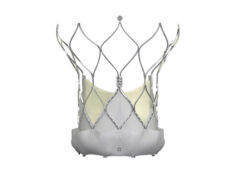This advertorial is sponsored by Boston Scientific
 Stroke—particularly disabling stroke—is among the major potential complications of a transcatheter aortic valve implantation (TAVI) procedure. In this advertorial, the second in a two-part series sponsored by Boston Scientific, interventional cardiologists Vlasis Ninios (Heart Center Thessaloniki, Kalamaria, Greece) and Ole De Backer (Rigshospitalet, Copenhagen, Denmark) reflect on the impact of stroke on the delivery of TAVI and offer their views on the key steps to limit its occurrence in their daily practice.
Stroke—particularly disabling stroke—is among the major potential complications of a transcatheter aortic valve implantation (TAVI) procedure. In this advertorial, the second in a two-part series sponsored by Boston Scientific, interventional cardiologists Vlasis Ninios (Heart Center Thessaloniki, Kalamaria, Greece) and Ole De Backer (Rigshospitalet, Copenhagen, Denmark) reflect on the impact of stroke on the delivery of TAVI and offer their views on the key steps to limit its occurrence in their daily practice.
“For a country like Greece, with a population of around 10 million, if we follow the European average we are talking about 1,500 TAVI procedures per year,” says Ninios, explaining that the potential risk of a stroke occurring during or immediately after a TAVI procedure can be viewed simply and starkly. “If you have a disabling stroke rate [of] between 1–2% you are talking about a significant number of individuals whose life will be totally disabled despite a successful TAVI procedure.”

“What we want to avoid is to decrease the quality of life because of a disabling stroke,” adds De Backer, who comments that though the impact of stroke may be felt acutely by the patient and their immediate family, there are also wider consequences for society and healthcare systems at large. “We are not only talking about elderly patients, but also younger patients who may still be active economically or caring for their grandchildren or a partner, so for sure there is an economical value in avoiding stroke related to TAVI.”
Both interventionalists tell Cardiovascular News that the risk of stroke is something that is often discussed with patients prior to a procedure, and Ninios comments that for many of those in whom he performs a TAVI, stroke is seen as the worst potential outcome.
“Many people are more afraid of stroke than of death,” he says. “The last thing you need as a cardiologist is to have a successful procedure, but a patient with a major disability coming out of the hospital.”

Prior to performing a TAVI procedure, much of the focus is upon preparing to get the best possible result for the valve implantation, adds De Backer, who comments that this may mean that there is less focus upon preparing the procedure in a way that stroke can be prevented as effectively as possible.
“We as operators and interventionalists are very focused on preparing as well as we can to get the best possible valve implant result, but we could also do the same to prevent stroke and to prepare ourselves and the patient as well as possible to prevent stroke,” he says.
Understanding the risk factors that may increase the likelihood of a patient suffering a stroke during or after a TAVI procedure are, therefore, an important first step to ensuring that the procedure can be performed as safely as possible for patients, and in particular those who may present the largest stroke risk.
De Backer identifies several characteristics to pay attention to, such as the level of calcification on the aortic valve, the presence of a bicuspid valve or a porcelain aorta, or the likely complexity of the implant, commonly seen in a valve-in-valve procedure. “If you look at the patient’s characteristics, we know that patients who had a previous stroke or patients who have very calcified peripheral artery disease are also at increased stroke risk,” adds De Backer. Ninios contributes that the presence of atrial fibrillation is also important, as well as any possible vascular disease.
New tools are emerging to address the risk of stroke during TAVI, and among them is the Sentinel (Boston Scientific) cerebral embolic protection system, which is designed to capture and remove embolic debris stemming from a TAVI procedure before it can reach the brain and potentially cause a stroke. Both Ninios and De Backer tell Cardiovascular News that they use cerebral embolic protection regularly in their practice, citing that that this is a potentially simple addition to a TAVI procedure that can benefit patients.
“A turning point was a young patient that had a devastating stroke that we did not anticipate,” says Ninios on his experience using cerebral embolic protection in practice. “It was a 76-year-old patient that was a high risk for surgery. We had a very smooth TAVI procedure, but the patient never came out of it, practically,” he recalls of the complication. Since this time, embolic protection has become routine in his practice.
“First of all, it is a very easy device [to use],” adds De Backer, noting that it does not come “at the penalty of safety”, a factor that he states is very important. Though it is impossible to state for certain whether there are cases in which this technique has successfully prevented strokes, De Backer comments that anecdotally, the effect is stark.
“There are cases where we have found quite some debris in these filters,” he explains. “We do not know how these patients would have done clinically if we would not have used the filter, but there is a common sense that when you see what you are catching through the filters you may be happy that you used them in some patients.”

The Sentinel system has been studied in one of the largest clinical trials in TAVI performed to date—PROTECTED TAVR—with the results having been shared at the 2022 Transcatheter Cardiovascular Therapeutics meeting (TCT, 16–19 September, Boston, USA) and published simultaneously in The New England Journal of Medicine. The trial randomised a total of 3,000 aortic stenosis patients from across 51 centres in North America, Europe and Australia to undergo TAVI with or without the use of a cerebral embolic protection device, with a primary endpoint of stroke within 72 hours after the procedure or before discharge.
Key results from the trial showed that the primary endpoint, the incidence of stroke within 72 hours after TAVI or before discharge, did not differ significantly between the cerebral embolic protection group and the control group (2.3% vs. 2.9% p=0.30), though significantly, according to investigators, disabling stroke occurred in 0.5% of the patients in the cerebral embolic protection group and in 1.3% of those in the control group (p=0.02).
Though the trial failed to meet its primary endpoint, both De Backer and Ninios comment that they see a benefit to the technology.
“To me it does not really change my vision, because I have had a good experience with the device,” offers De Backer. “The signal in the study of a reduction of disabling stroke is—though maybe not statistically significant—clinically important and clinically significant.
“If I can just prevent a couple of clinically significant disabling strokes in my practice this is very important for me as a physician, but even more so for the patients.”
Ninios goes further, adding that more research can clarify in which patients cerebral embolic protection devices offer the most benefit. “Further research will clarify perhaps the subset of patients that will benefit, but, even if it does not do that, perhaps it will give us further insight to what we are preventing and what is the benefit that we are providing to our patients. In my opinion we are protecting our patients and that is very important.”
 TAVI is here to stay, concludes Ninios, commenting that it will “dominate” the treatment of aortic stenosis in the next decade. Anything that can be done to make the treatment safer, should be considered as important, he says. “We need to make sure that we do everything in our power to reduce the complications, especially stroke, as close to zero as possible.”
TAVI is here to stay, concludes Ninios, commenting that it will “dominate” the treatment of aortic stenosis in the next decade. Anything that can be done to make the treatment safer, should be considered as important, he says. “We need to make sure that we do everything in our power to reduce the complications, especially stroke, as close to zero as possible.”










